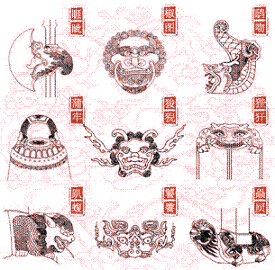关于龙生九子的传说英语故事 附中文版含九子的名字及习性

俗话常说“龙生九子,九子各有不同”,关于这句话有一个很长的故事,就是龙生了9个儿子,每个儿子的习性却完全不同,下面是关于龙生九子的故事英语版及中文版。
2012 is the year of dragon. some people say 2012 is a black dragon or water dragon year. this is because the stem-branch calendar is connected to the five element theory. chinese calendars used the stem-branch system to count the days, months and years. there are 10 stems and 12 branches in this system. stems are named by the yin-yang and five elements (metal, water, wood, fire and earth). the stem sequence order is yang wood, yin wood, yang fire, yin fire, yang earth, yin earth, yang metal, yin metal, yang water and yin water. branches use animal names.
the branch sequence order is rat, cow, tiger, dragon, dragon, snake, horse, sheep, monkey, chicken, dog and pig. stem and branch are used together to form a cycle of 60 counting systems which begin with wooden rat and end with water pig. you can see the entire sequence from the chinese new year's page. from 1924 to 1983 is a complete cycle. year 2012 is male water dragon the 29th of the stem-branch in the system. because water is connected to black in the five-element system, year 2012 is also called the black dragon year.
dragon has nine sons
a dragon is a legendary creature. all legendary stories about chinese dragons are from the sky, which means heaven in china. the image of dragon is blurred, misty, mystic, occulted, noble and untouchable. for china, it is the symbol of power from heaven. the chinese emperor was considered the son of heaven. an emperor has the authority to send command to dragons. one chinese story mentioned an emperor killed a dragon in his dream. after 581 ad, chinese emperors began to wear imperial robes with dragon symbols. during the ching dynasty (1644-1911 ad), the dragon can be seen everywhere on the roofs, doors, pillars, bridges, utensils in the forbidden city. the most powerful dragon is the five-clawed dragon. it appears only on the yellow imperial robe. because of this, dragon is one of most auspicious animals in china.
they say that dragon has nine sons. people didn't know too much about the nine dragons until ming dynasty (1368-1644 ad). however, there is more than one version of the nine dragons story. one story is the following.
the dragon sent its nine sons to help the first emperor of ming dynasty to conquer china. after completing the mission, nine dragons were preparing their journey to return to heaven. but the emperor wanted them to continue to help the ming dynasty. the nine dragons wouldn't stay and the emperor couldn't stop them. however, the emperor decided to play a trick on the most powerful dragon, the 6th son. he tricked the sixth dragon son to carry a magic stele with a carved inscription, which could suppress any ghost, spirit or evil creature. the 6th dragon couldn't move under the magic stele, and all of his other brothers wouldn't leave without him. however, they wouldn't work for the emperor anymore. they decided to no longer show their dragon identities and turned themselves into evil creatures. since then, the nine dragons have stayed in china.
the nine dragon have different themes, and they all have different versions too. we skip their names because all of their names are hard to remember. one version is:
the 1st son loves music. the head of number 1 son becomes a decoration for music instrument, such as two-stringed bowed violin (huqin).
the 2nd son loves fighting. many different handles of weapons have the symbol of number 2 son.
the 3rd son loves adventure and keeping guard. he has prestige and is the symbol of safety, harmony and peace.
the 4th son loves howling. the image of number 4 son can be found on the big bells. it is a symbol of protection and alertness.
the 5th son loves quietness, sitting, fire and smoke. his image is often found in temples, such as on incense burners.
the 6th son has the power of strength. he loves to carry heavy stuff to show off his magic energy. he is a symbol of longevity and good luck.
the 7th son loves to seek justice. chinese like to apply his symbol around law, court, or jail.
the 8th son loves literature. chinese like to put the 8th son as a symbol around steles. when used in this way, it is a symbol of knowledge or education.
the 9th son loves water. he is a symbol to prevent fire disasters
《中国吉祥图说》中描述为:九子之老大叫囚牛,喜音乐,蹲立于琴头;老二叫睚眦(ya zi),嗜杀喜斗,刻镂于刀环、剑柄吞口;老三叫嘲风,平生好险,今殿角走兽是其遗像;四子蒲牢,受击就大声吼叫,充作洪钟提梁的兽钮,助其鸣声远扬;五子狻猊(suan ni),形如狮,喜烟好坐,倚立于香炉足上,随之吞烟吐雾;六子霸下,又名xx(bi xi),似龟有齿,喜欢负重,碑下龟是也;七子狴犴(bi gan),形似虎好讼,狱门或官衙正堂两侧有其像;八子负质,身似龙,雅好斯文,盘绕在石碑头顶;老九螭(chi)吻,又名鸱尾或鸱(chi)吻,口润嗓粗而好吞,遂成殿脊两端的吞脊兽,取其灭火消灾。
在《大千传统图案网》中解释比较详尽:
龙生九子之一·囚牛
囚牛,是龙生九子中的老大,平生爱好音乐,它常常蹲在琴头上欣赏弹拨弦拉的音乐,因此琴头上便刻上它的遗像。这个装饰现在一直沿用下来,一些贵重的胡琴头部至今仍刻有龙头的形象,称其为“龙头胡琴”。
龙生九子之二·睚眦
睚眦,是老二,平生好斗喜杀,刀环、刀柄、龙吞口便是它的遗像。这些武器装饰了龙的形象后,更增添了慑人的力量。它不仅装饰在沙场名将的兵器上,更大量地用在仪仗和宫殿守卫者武器上,从而更显得威严庄重。
龙生九子之三·嘲风
嘲风,形似兽,是老三,平生好险又好望,殿台角上的走兽是它的遗像。这些走兽排列着单行队,挺立在垂脊的前端,走兽的领头是一位骑禽的“仙人”,后面依次为:龙、凤、狮子、天马、海马、狻猊、押鱼、獬豸、斗牛、和行什。它们的安放有严格的等级制度,只有北京故宫的太和殿才能十样俱全,次要的殿堂则要相应减少。嘲风,不仅象征着吉祥、美观和威严,而且还具有威慑妖魔、清除灾祸的含义。嘲风的安置,使整个宫殿的造型既规格严整又富于变化,达到庄重与生动的和谐,宏伟与精巧的统一,它使高耸的殿堂平添一层神秘气氛。
龙生九子之四·蒲牢
蒲牢,形似盘曲的龙,排行第四,平生好鸣好吼,洪钟上的龙形兽钮是它的遗像。原来蒲牢居住在海边,虽为龙子,却一向害怕庞然大物的鲸鱼。当鲸鱼一发起攻击,它就吓得大声吼叫。人们报据其“性好鸣”的特点,“凡钟欲令声大音”,即把蒲牢铸为钟纽,而把敲钟的木杵作成鲸鱼形状。敲钟时,让鲸鱼一下又一下撞击蒲牢,使之“响入云霄”且“专声独远”。
龙生九子之五·狻猊
狻猊,形似狮子,排行第五,平生喜静不喜动,好坐,又喜欢烟火,囚此佛座上和香炉上的脚部装饰就是它的遗像。相传这种佛座上装饰的狻猊是随着佛教在汉代由印度人传入中国的,至南北朝时期,我国的佛教艺术上已普遍使用,这种造型经过我国民间艺人的创造,使其具有中国的传统气派,后来成了龙子的老五,它布置的地方多是在结跏趺坐或交脚而坐的佛菩萨像前。明清之际的石狮或铜狮颈下项圈中间的龙形装饰物也是狻猊的形象,它使守卫大门的中国传统门狮更为睁崃威武。
龙生九子之六·霸下
霸下,又名赑屃,形似龟,是老六,平生好负重,力大无穷,碑座下的龟趺是其遗像。传说霸下上古时代常驮着三山五岳,在江河湖海里兴风作浪。后来大禹治水时收服了它,它服从大禹的指挥,推山挖沟,疏遍河道,为治水作出了贡献。洪水治服了,大禹担心霸下又到处撒野,便搬来顶天立地的特大石碑,上面刻上霸下治水的功迹,叫霸下驮着,沉重的石碑压得它不能随便行走。霸下和龟十分相似,但细看却有差异,霸下有一排牙齿,而龟类却没有,霸下和龟类在背甲上甲片的数目和形状也有差异。霸下又称石龟,是长寿和吉祥的象征。它总是吃力地向前昂着头,四只脚拼命地撑着,挣扎着向前走,但总是移不开步。我国一些显赫石碑的基座都由霸下驮着,在碑林和一些古迹胜地中都可以看到。
龙生九子之七·狴犴
狴犴,又名宪章,形似虎,是老七。它平生好讼,却又有威力,狱门上部那虎头形的装饰便是其遗像。传说狴犴不仅急公好义,仗义执言,而且能明辨是非,秉公而断,再加上它的形象威风凛凛,囚此除装饰在狱门上外,还匐伏在官衙的大堂两侧。每当衙门长官坐堂,行政长官衔牌和肃静回避牌的上端,便有它的形象,它虎视眈眈,环视察看,维护公堂的肃穆正气。
龙生九子之八·负屃
负屃,似龙形,排行老八,平生好文,石碑两旁的文龙是其遗像。我国碑碣的历史久远,内容丰富,它们有的造型古朴,碑体细滑、明亮,光可鉴人;有的刻制精致,字字有姿,笔笔生动;也有的是名家诗文石刻,脍灸人口,千古称绝。而负屃十分爱好这种闪耀着艺术光彩的碑文,它甘愿化做图案文龙去衬托这些传世的文学珍品,把碑座装饰得更为典雅秀美。它们互相盘绕着,看去似在慢慢蠕动,和底座的霸下相配在一起,更觉壮观。
龙生九子之九·螭吻
螭吻,又名鸱尾、鸱吻,龙形的吞脊兽,是老九,口阔噪粗,平生好吞,殿脊两端的卷尾龙头是其遗像。《太平御览》有如下记述:“唐会要目,汉相梁殿灾后,越巫言,‘海中有鱼虬,尾似鸱,激浪即降雨’遂作其像于尾,以厌火祥。”文中所说的“巫”是方士之流,“鱼虬”则是螭吻的前身。螭吻属水性,用它作镇邪之物以避火。

俗话常说“龙生九子,九子各有不同”,关于这句话有一个很长的故事,就是龙生了9个儿子,每个儿子的习性却完全不同,下面是关于龙生九子的故事英语版及中文版。
《中国吉祥图说》中描述为:九子之老大叫囚牛,喜音乐,蹲立于琴头;老二叫睚眦(ya zi),嗜杀喜斗,刻镂于刀环、剑柄吞口;老三叫嘲风,平生好险,今殿角走兽是其遗像;四子蒲牢,受击就大声吼叫,充作洪钟提梁的兽钮,助其鸣声远扬;五子狻猊(suan ni),形如狮,喜烟好坐,倚立于香炉足上,随之吞烟吐雾;六子霸下,又名xx(bi xi),似龟有齿,喜欢负重,碑下龟是也;七子狴犴(bi gan),形似虎好讼,狱门或官衙正堂两侧有其像;八子负质,身似龙,雅好斯文,盘绕在石碑头顶;老九螭(chi)吻,又名鸱尾或鸱(chi)吻,口润嗓粗而好吞,遂成殿脊两端的吞脊兽,取其灭火消灾。
在《大千传统图案网》中解释比较详尽:
龙生九子之一·囚牛
囚牛,是龙生九子中的老大,平生爱好音乐,它常常蹲在琴头上欣赏弹拨弦拉的音乐,因此琴头上便刻上它的遗像。这个装饰现在一直沿用下来,一些贵重的胡琴头部至今仍刻有龙头的形象,称其为“龙头胡琴”。
龙生九子之二·睚眦
睚眦,是老二,平生好斗喜杀,刀环、刀柄、龙吞口便是它的遗像。这些武器装饰了龙的形象后,更增添了慑人的力量。它不仅装饰在沙场名将的兵器上,更大量地用在仪仗和宫殿守卫者武器上,从而更显得威严庄重。
龙生九子之三·嘲风
嘲风,形似兽,是老三,平生好险又好望,殿台角上的走兽是它的遗像。这些走兽排列着单行队,挺立在垂脊的前端,走兽的领头是一位骑禽的“仙人”,后面依次为:龙、凤、狮子、天马、海马、狻猊、押鱼、獬豸、斗牛、和行什。它们的安放有严格的等级制度,只有北京故宫的太和殿才能十样俱全,次要的殿堂则要相应减少。嘲风,不仅象征着吉祥、美观和威严,而且还具有威慑妖魔、清除灾祸的含义。嘲风的安置,使整个宫殿的造型既规格严整又富于变化,达到庄重与生动的和谐,宏伟与精巧的统一,它使高耸的殿堂平添一层神秘气氛。
龙生九子之四·蒲牢
蒲牢,形似盘曲的龙,排行第四,平生好鸣好吼,洪钟上的龙形兽钮是它的遗像。原来蒲牢居住在海边,虽为龙子,却一向害怕庞然大物的鲸鱼。当鲸鱼一发起攻击,它就吓得大声吼叫。人们报据其“性好鸣”的特点,“凡钟欲令声大音”,即把蒲牢铸为钟纽,而把敲钟的木杵作成鲸鱼形状。敲钟时,让鲸鱼一下又一下撞击蒲牢,使之“响入云霄”且“专声独远”。
龙生九子之五·狻猊
狻猊,形似狮子,排行第五,平生喜静不喜动,好坐,又喜欢烟火,囚此佛座上和香炉上的脚部装饰就是它的遗像。相传这种佛座上装饰的狻猊是随着佛教在汉代由印度人传入中国的,至南北朝时期,我国的佛教艺术上已普遍使用,这种造型经过我国民间艺人的创造,使其具有中国的传统气派,后来成了龙子的老五,它布置的地方多是在结跏趺坐或交脚而坐的佛菩萨像前。明清之际的石狮或铜狮颈下项圈中间的龙形装饰物也是狻猊的形象,它使守卫大门的中国传统门狮更为睁崃威武。
龙生九子之六·霸下
霸下,又名赑屃,形似龟,是老六,平生好负重,力大无穷,碑座下的龟趺是其遗像。传说霸下上古时代常驮着三山五岳,在江河湖海里兴风作浪。后来大禹治水时收服了它,它服从大禹的指挥,推山挖沟,疏遍河道,为治水作出了贡献。洪水治服了,大禹担心霸下又到处撒野,便搬来顶天立地的特大石碑,上面刻上霸下治水的功迹,叫霸下驮着,沉重的石碑压得它不能随便行走。霸下和龟十分相似,但细看却有差异,霸下有一排牙齿,而龟类却没有,霸下和龟类在背甲上甲片的数目和形状也有差异。霸下又称石龟,是长寿和吉祥的象征。它总是吃力地向前昂着头,四只脚拼命地撑着,挣扎着向前走,但总是移不开步。我国一些显赫石碑的基座都由霸下驮着,在碑林和一些古迹胜地中都可以看到。
龙生九子之七·狴犴
狴犴,又名宪章,形似虎,是老七。它平生好讼,却又有威力,狱门上部那虎头形的装饰便是其遗像。传说狴犴不仅急公好义,仗义执言,而且能明辨是非,秉公而断,再加上它的形象威风凛凛,囚此除装饰在狱门上外,还匐伏在官衙的大堂两侧。每当衙门长官坐堂,行政长官衔牌和肃静回避牌的上端,便有它的形象,它虎视眈眈,环视察看,维护公堂的肃穆正气。
龙生九子之八·负屃
负屃,似龙形,排行老八,平生好文,石碑两旁的文龙是其遗像。我国碑碣的历史久远,内容丰富,它们有的造型古朴,碑体细滑、明亮,光可鉴人;有的刻制精致,字字有姿,笔笔生动;也有的是名家诗文石刻,脍灸人口,千古称绝。而负屃十分爱好这种闪耀着艺术光彩的碑文,它甘愿化做图案文龙去衬托这些传世的文学珍品,把碑座装饰得更为典雅秀美。它们互相盘绕着,看去似在慢慢蠕动,和底座的霸下相配在一起,更觉壮观。
龙生九子之九·螭吻
螭吻,又名鸱尾、鸱吻,龙形的吞脊兽,是老九,口阔噪粗,平生好吞,殿脊两端的卷尾龙头是其遗像。《太平御览》有如下记述:“唐会要目,汉相梁殿灾后,越巫言,‘海中有鱼虬,尾似鸱,激浪即降雨’遂作其像于尾,以厌火祥。”文中所说的“巫”是方士之流,“鱼虬”则是螭吻的前身。螭吻属水性,用它作镇邪之物以避火。
2012 is the year of dragon. some people say 2012 is a black dragon or water dragon year. this is because the stem-branch calendar is connected to the five element theory. chinese calendars used the stem-branch system to count the days, months and years. there are 10 stems and 12 branches in this system. stems are named by the yin-yang and five elements (metal, water, wood, fire and earth). the stem sequence order is yang wood, yin wood, yang fire, yin fire, yang earth, yin earth, yang metal, yin metal, yang water and yin water. branches use animal names.
the branch sequence order is rat, cow, tiger, dragon, dragon, snake, horse, sheep, monkey, chicken, dog and pig. stem and branch are used together to form a cycle of 60 counting systems which begin with wooden rat and end with water pig. you can see the entire sequence from the chinese new year's page. from 1924 to 1983 is a complete cycle. year 2012 is male water dragon the 29th of the stem-branch in the system. because water is connected to black in the five-element system, year 2012 is also called the black dragon year.
dragon has nine sons
a dragon is a legendary creature. all legendary stories about chinese dragons are from the sky, which means heaven in china. the image of dragon is blurred, misty, mystic, occulted, noble and untouchable. for china, it is the symbol of power from heaven. the chinese emperor was considered the son of heaven. an emperor has the authority to send command to dragons. one chinese story mentioned an emperor killed a dragon in his dream. after 581 ad, chinese emperors began to wear imperial robes with dragon symbols. during the ching dynasty (1644-1911 ad), the dragon can be seen everywhere on the roofs, doors, pillars, bridges, utensils in the forbidden city. the most powerful dragon is the five-clawed dragon. it appears only on the yellow imperial robe. because of this, dragon is one of most auspicious animals in china.
they say that dragon has nine sons. people didn't know too much about the nine dragons until ming dynasty (1368-1644 ad). however, there is more than one version of the nine dragons story. one story is the following.
the dragon sent its nine sons to help the first emperor of ming dynasty to conquer china. after completing the mission, nine dragons were preparing their journey to return to heaven. but the emperor wanted them to continue to help the ming dynasty. the nine dragons wouldn't stay and the emperor couldn't stop them. however, the emperor decided to play a trick on the most powerful dragon, the 6th son. he tricked the sixth dragon son to carry a magic stele with a carved inscription, which could suppress any ghost, spirit or evil creature. the 6th dragon couldn't move under the magic stele, and all of his other brothers wouldn't leave without him. however, they wouldn't work for the emperor anymore. they decided to no longer show their dragon identities and turned themselves into evil creatures. since then, the nine dragons have stayed in china.
the nine dragon have different themes, and they all have different versions too. we skip their names because all of their names are hard to remember. one version is:
the 1st son loves music. the head of number 1 son becomes a decoration for music instrument, such as two-stringed bowed violin (huqin).
the 2nd son loves fighting. many different handles of weapons have the symbol of number 2 son.
the 3rd son loves adventure and keeping guard. he has prestige and is the symbol of safety, harmony and peace.
the 4th son loves howling. the image of number 4 son can be found on the big bells. it is a symbol of protection and alertness.
the 5th son loves quietness, sitting, fire and smoke. his image is often found in temples, such as on incense burners.
the 6th son has the power of strength. he loves to carry heavy stuff to show off his magic energy. he is a symbol of longevity and good luck.
the 7th son loves to seek justice. chinese like to apply his symbol around law, court, or jail.
the 8th son loves literature. chinese like to put the 8th son as a symbol around steles. when used in this way, it is a symbol of knowledge or education.
the 9th son loves water. he is a symbol to prevent fire disasters

